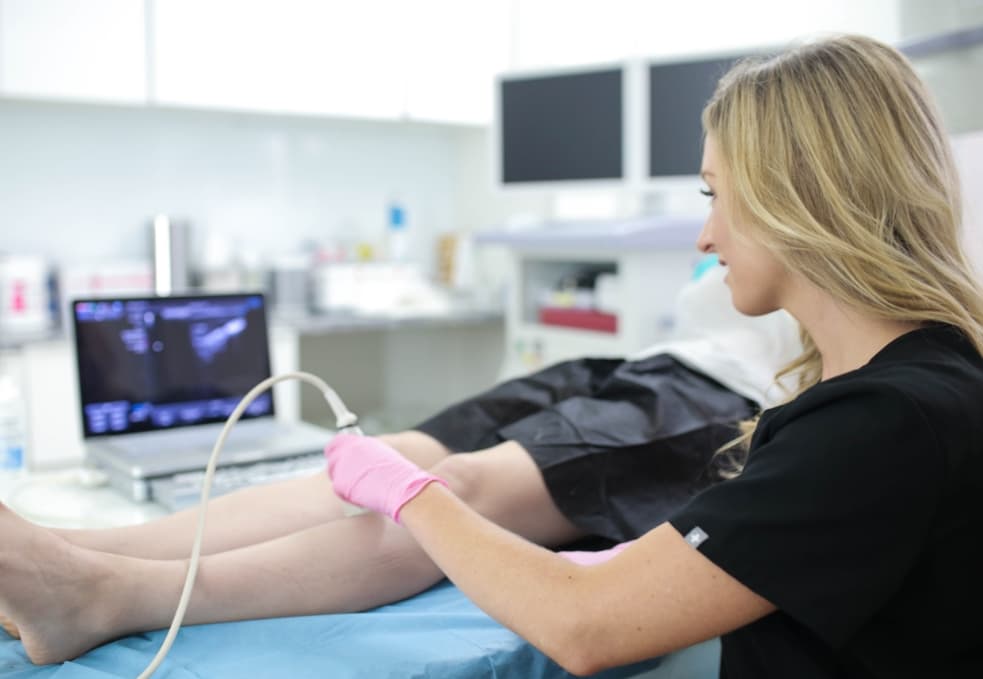#1. Radiofrequency Ablation
Radiofrequency ablation is one of the most effective minimally invasive treatments for chronic venous insufficiency. The vein doctor channels thermal energy into the diseased saphenous vein via a catheter to seal it shut. The diseased vein collapses and gets reabsorbed by the body, and the accumulated blood reroutes into healthier leg veins.
#2. Endovenous Laser Ablation
Endovenous laser ablation was the first minimally invasive vein treatment to be developed. This procedure involves inserting a specialized laser fiber into the diseased vein under ultrasound guidance and activating it to generate laser energy. The laser energy creates an inflammatory response to destroy the diseased vein, rerouting the accumulated blood into healthier veins.
#3. VenaSeal
VenaSeal is a minimally invasive treatment for diseased veins. The vein doctor makes a small incision on the skin’s surface to insert a catheter and deliver a medical-grade adhesive that seals the veins’ walls shut. The accumulated blood reroutes into healthier leg veins and restores optimal blood circulation to the heart.

#4. Sclerotherapy (for Spider Veins)
Sclerotherapy is a minimally invasive spider vein treatment. The vein doctor injects a sclerosant solution into the unhealthy spider veins to seal their walls shut, turning them into hardened tissues, eventually reabsorbed by the body. The spider veins soon fade away from the skin’s surface. This procedure doesn’t treat underlying vein disease, but it improves the appearance of your skin.
#5. Ambulatory Phlebectomy (for Varicose Veins)
Ambulatory phlebectomy is a minimally invasive procedure for superficial varicose veins. The board-certified vein doctor makes small incisions on the skin’s surface and uses a hook-like device to extract the unhealthy varicose veins. This procedure offers instant relief from varicose veins — the incision marks gradually heal and fade away from the skin’s surface.
FAQs About Chronic Venous Insufficiency
What is chronic venous insufficiency?
Chronic venous insufficiency (CVI) is a condition that occurs when the veins in your legs are unable to efficiently pump deoxygenated blood back to your heart. This can cause blood to pool in your legs and lead to a number of symptoms, including pain, swelling, and skin changes. CVI is a common condition affecting up to 30% of adults.
While it can occur at any age, chronic venous insufficiency is most common in people over the age of 50. CVI can be caused by a number of factors, including genetics, obesity, and pregnancy. Treatment for CVI typically involves lifestyle changes, wearing compression stockings, and minimally invasive vein treatments. Our vein doctors recommend the ideal vein treatments for your specific needs.
What are the signs and symptoms of vein disease?
- Varicose veins — bulging, enlarged veins that are often blue or dark purple
- Spider veins — smaller, red, purple, or blue veins that often look like a spider web
- Bulging veins
- Painful veins
- Swelling in your legs
- Skin changes around your veins, such as redness, ulcers, or sores
- Leg cramps
- Restless legs
- Heavy feeling in your legs
- Itching or burning sensation in your legs
How can I prevent vein disease?
Vein disease is a common condition that can lead to serious health problems. While there are no certain means of preventing vein disease, you can do a few things to minimize the risk:
- Exercise regularly. This will help to improve your circulation and prevent blood from pooling in your veins.
- Eat a healthy diet. This will help to keep your veins healthy and prevent blockages.
- Wear loose-fitting clothing. This will help to improve circulation and prevent vein damage.
- Avoid sitting or standing for long periods of time. This can cause blood to pool in your veins and lead to vein disease.
- If you have a job that requires you to sit or stand for long periods of time, take breaks often to move around. This will help to improve your circulation.
- Quit smoking. This will help to improve your circulation and prevent vein damage.
- Wear compression stockings. This will prevent the accumulation of blood in the leg veins.
How to treat a collapsed vein?
A collapsed vein is a medical condition where the walls of the vein collapse, leading to the accumulation of blood in the leg veins. The collapsed vein may be painful and cause swelling. If the vein is in the leg, it may also cause a feeling of heaviness or fatigue. The best vein doctors offer cutting-edge, minimally invasive treatments to destroy the diseased saphenous vein responsible for your vein problems. Once the diseased vein is destroyed, it turns into hardened scar tissue, eventually reabsorbed by the body. Meanwhile, the accumulated blood reroutes into healthier leg veins to restore optimal blood circulation to the heart.
What kind of doctor treats chronic venous insufficiency?
A doctor who treats chronic venous insufficiency is called a vein specialist, vein doctor, or phlebologist. Vein doctors have special training in diagnosing and treating problems with the veins. They use ultrasound diagnostic tests to visualize the blood flow in your leg veins and curate a personalized vein treatment plan, which may include radiofrequency ablation, endovenous laser ablation, venaseal, sclerotherapy, ambulatory phlebectomy, or a combination of these procedures.
Maryland Vein Center is led by highly-skilled, board-certified vein doctors specializing in the latest and safety minimally invasive procedures. If you’re in or around the Beltway, you can find our vein doctors at 10215 Fernwood Rd, Suite 301, Bethesda, Maryland, just outside of Washington, DC. Please schedule an appointment to explore your treatment options for chronic venous insufficiency.




